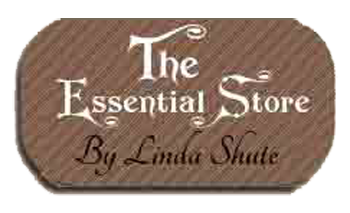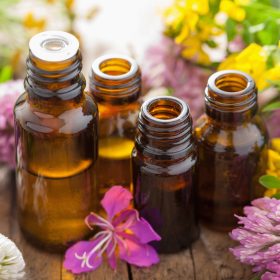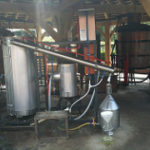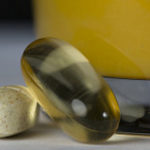Essential Oils for Healing the Skin
There are a few primary oils used in skin repair. First, and possibly most important, is Helichrysum Italicum, also known as Everlasting. This oil with a lovely earthy aroma is distilled from the brightly-colored, daisy-like flowers of a strongly aromatic herb native to the Mediterranean region. Helichrysum is one of the most highly regarded oils in aromatherapy for it’s broad range of healing properties for body tissues. It is a bit more expensive due to it’s low yield in processing, but produces it’s wonderful effects in very small doses.
The Power of Helichrysum
Helichrysum can be used in a simple carrier oil by itself, though it is considered synergistic with Rosehip seed oil and with Lavender essential oil. This easy-to-make combination has been noted by professional aromatherapists to “heal wounds with minimal or no scarring” though the nutritive triple unsaturated fatty acids and vitamin A compounds of Rosehip seed, combined with the anti-inflammatory and regenerative properties of the Helichrysum. Helichrysum can be a little bit pricey, but it’s wonderful effects have been noted at very low concentrations of the total blend – a little will go a long way.
Lavender to Balance and Sooth
As mentioned above, Lavender is often included in skin care blends – it has gentle anti-inflammatory and tissue regenerative properties, along with very soothing, anti-anxiety aroma. This stress-relieving action seems to be imparted even at the cellular level where wound healing occurs. Lavender essential oil itself began the modern aromatherapy revolution when a scientist burned his hand in a laboratory accident, and after cooling the wound in a beaker of Lavender found the wound to heal remarkably quickly.
Sage: Regeneration for Old Wounds and Scars
Next up is the essential oil distilled from the leaves of common Sage, or Salvia officinalis. Sage is used in low concentrations in very specific conditions – where the scars are old and require a little extra phytochemical power to heal. Sage oil can bring circulation to the area, and can assist the scarred area of the skin to regenerate, particularly in concert with other oils. Sage can be used in stretch mark formulas, but should only be employed post-partum because of the high thujone content of the oil.
Stimulating Skin Cell Health with Rosemary
Rosemary of the Verbenone chemotype (rather than Cineol, which does not have the same properties) contains regenerative ketones like Lavender and Helichrysum, plus has the added benefit of stimulating the skin’s metabolic process. This oil can bring greater circulation to skin tissues, delivering nutrients and eliminating cellular waste and toxins — functions which are crucial during the healing process. Rosemary Verbenone can be used for healing new or old wounds.
Nutritive Essential Oils Speed Healing
Other essential oils can offer important nutrient that may speed the healing process. Most importantly, they offer carotenoids and carotenes — natural vitamin-A-like compounds needed for increasing the strength of the healing tissue. Two essential oils can be chosen from: Sea Buckthorn and Carrot Root. These are both found as CO2 extracts with deep colors, indicating the high levels of nutrients.
Antiseptics/Antimicrobials For Wound Care
For wounds that are currently healing, a small amount of an antimicrobial oil can help the process. It can prevent redness and irritation that is the result of your body dealing with bacteria at the sight of the injury. Between 8 and 40 drops of Tea Tree per ounce of your complete formula can be added if you feel a stronger antiseptic action is necessary (Lavender and Rosemary do have moderate antimicrobial properties). A second formula without Tea Tree can be used once the wound is completely sealed.
The Carrier Oils: Diluting and Delivering the Essential Oils
Finally, these essential oils need to be diluted carrier oils, which are seed or nut oils made up of fatty acids. These oils help the skin absorb the essential oils, and provide important nutritive oils to help the skin heal and look its best. The most important is Rosehip Seed oil, cold-pressed from Rosehip Seeds native to mountainous regions of South America. In addition to its unsaturated fatty acids, this oil contains natural vitamin A compounds similar in effect to the pharmaceutical preparation Retin-A but without the over drying or redness that often accompanies its use. Note that Rosehip seed should NOT be used for acne scars where acne outbreaks are still likely to occur. Tamanu Nut oil — or Callophylum — is a little known oil that actually lies somewhere between a ‘fixed oil’ and ‘essential oil’ in its chemistry. Tamanu is an excellent choice for healing all types of wounds. Finally, oils containing high amounts of omega-3 fatty acids can help healing by providing important nutrients while reducing inflammation.
Easy Mixing: Simple Recipes for Common Conditions
And now for a few recipes – a few simple mixtures can cover several skin-healing conditions, both for recent wounds and older scarred tissue. For the support of recent wounds, use one ounce Tamanu and one ounce Rosehip seed oils. To this, add 25 drops each of Helichrysum and Lavender essential oils, plus up to 75 drops of your choice of either Sea Buckthorn or Carrot Root – apply twice a day once the wound can get moist (wait until there is no chance of bleeding). For the improvement of appearance of old scars, keloid scars and acne scars, try the same base oils, replacing the Lavender with Sage essential oil. Use Hazelnut instead of Rosehip seed if you are still prone to an acne outbreak. Apply regularly for 3 to 6 months for best results. For the post-partum reduction of stretch marks, again to the same base oil formula, add 25 drops Sage essential oil and 25 drops Rosemary verbenone. Use this formula again for several months for best results.
So there are a few effective combinations of natural botanical ingredients that can support certain skin care conditions. Many, many more skin care formulas are available when blending essential oils – with many oils able to aid with very particular situations. If needed, a little research should go a long way in helping you find what you need. And as always with aromatherapy oils, go slowly, pay attention to your body’s reactions and remember that increasing concentrations of the essential oils will not make a more effective blend. Be safe and enjoy.
Related Essential Oils Articles










Leave a reply